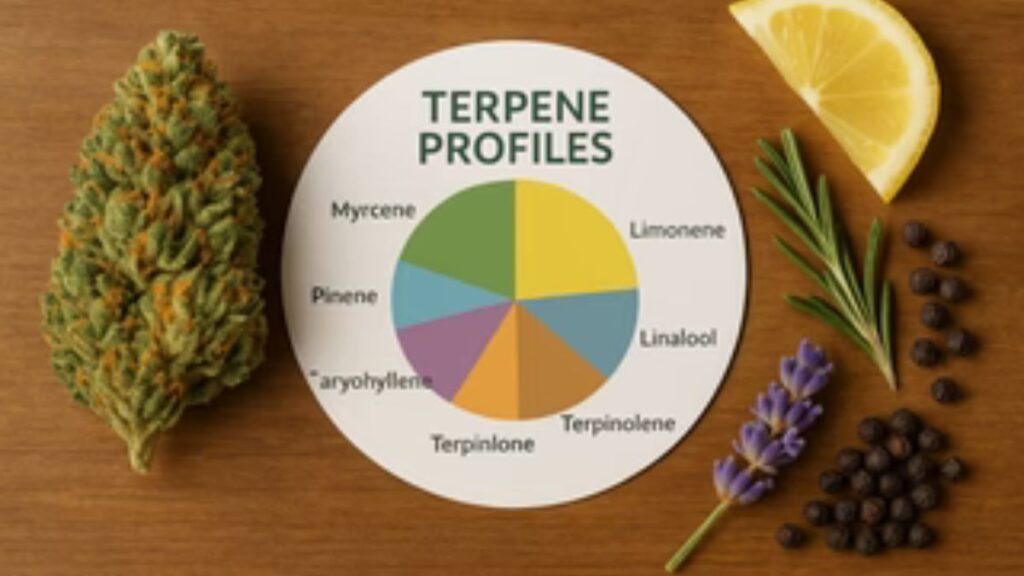Introduction to Terpenes in THCA Flower
When exploring the world of THCA flower, aroma and flavor often take center stage, intoxicating the senses with their distinct and sometimes complex signatures. Yet, the secret to these vibrant sensory experiences lies deeper within the plant, owing to terpenes—naturally occurring aromatic compounds that are much more influential than most people realize. Terpenes determine the scent and taste of each strain and play a pivotal role in how the flower affects the body and mind, weaving together the sensory and the therapeutic in one elegant package. For those seeking a premium selection of terpene-rich options that cater to different preferences and occasions, the Gold Spectrum THCA Flower collection offers a diverse array tailored for unique experiences and nuanced effects.
Terpenes are not exclusive to cannabis; they are abundant throughout nature and are responsible for the distinct smells of fruits like oranges, herbs like basil, and flowers like lavender. However, their complexity in THCA flower is renowned for influencing the therapeutic properties and user experience, bridging the gap between scent, flavor, and biological effect. By gaining a solid understanding of terpenes, consumers can make more informed and empowered decisions, ensuring that the flower they choose closely matches their preferences and desired outcomes. Whether for stress relief, creativity, or calm, the right terpene profile can make all the difference.
Common Terpenes and Their Characteristics
THCA flower has a wide range of terpenes, each with unique aromatic and therapeutic properties that can significantly enhance the cannabis experience. Here are some of the most prevalent and impactful terpenes found in THCA flower and cannabis in general, helping shape the personality of each strain:
- Myrcene: Renowned for its earthy, musky notes, myrcene is the most abundant terpene in most cannabis strains. It is commonly linked to calm and sedative effects, making strains high in myrcene a favorite for relaxation and mellow evenings. Some say it adds a subtle hint of ripe mango or cloves, complementing other aromatic elements in the blend.
- Limonene: This citrus-forward terpene imparts a bright, uplifting aroma reminiscent of lemon peels or sweet oranges. Limonene is often celebrated for its mood-elevating properties, stress relief, and potential anti-anxiety effects. Strains with high levels of limonene are popular choices for daytime use, boosting motivation and positivity in social settings.
- Pinene: As the name implies, pinene is responsible for pine-scented notes and fresh, forest-like aromas. Its invigorating scent is matched by the potential to promote mental clarity, alertness, and focus. Some evidence suggests that pinene may help counteract short-term memory impairment sometimes associated with THC, making it an interesting component for balanced strains.
- Linalool: Carrying gentle floral and lavender scents, linalool is prized for its pronounced calming, anti-anxiety, and even potential antidepressant effects. This terpene is well-loved by those who seek stress reduction and relaxation without feeling overwhelmed or sedated, making it a staple for evening blends and wellness-focused options.
- Caryophyllene: Unique among terpenes for its ability to interact directly with the body’s endocannabinoid system, caryophyllene gives off a spicy, peppery aroma similar to cracked black pepper or cloves. In addition to its enticing scent, it shows promise for its anti-inflammatory and potential pain-relieving properties, bridging the gap between aroma and wellness.
[suggestion]A simple diagram showing five labeled aroma icons (earthy, citrus, pine, floral, pepper) each linked by arrows to a stylized THCA cannabis flower, visually representing the connection between terpenes and the flower’s aroma and effects.[/suggestion]
The Entourage Effect: Terpenes and Cannabinoids
One of the most fascinating aspects of modern cannabis science is the discovery of the “entourage effect”—a phenomenon where terpenes work in tandem with cannabinoids like THCA to amplify or modulate the plant’s overall effects on the body and mind. Rather than acting alone, phytochemicals such as limonene, myrcene, or caryophyllene can enhance the euphoric or relaxing qualities of cannabinoids, sometimes deepening certain benefits or balancing out side effects. This synergy means that even two strains with identical cannabinoid content might feel very different based on their terpene makeup. The multi-compound interaction that drives the entourage effect is a cornerstone of why terpene profiling is now highly valued among both connoisseurs and those using cannabis therapeutically.
Influence of Cultivation Methods on Terpene Profiles
The diversity and quality of terpene profiles in THCA flower are closely tied to how the plant is grown, harvested, and cared for throughout its life. Indoor cultivation allows precise control over critical factors such as lighting spectrum, temperature stability, and humidity levels. These stable conditions help support the consistent development and preservation of the flower’s intended terpene characteristics, resulting in a THCA flower that usually boasts strong, predictable aromas and effects. Many top-shelf strains are produced indoors for this reason.
Conversely, outdoor cultivation lets plants bask in the power of unfiltered sunlight, natural weather patterns, and the rich biology of living soil. This unique environment can yield a broader, sometimes more nuanced or unexpected, spectrum of terpenes. Elements like rain, microclimates, and healthy soil ecosystems influence terpene expression, contributing to more varied and robust aromatic signatures—even between different harvests of the same strain. However, this also brings less predictability and increased variability, making each outdoor crop a unique sensory journey.
Processing and Storage: Preserving Terpene Integrity
Retaining a flower’s unique terpene profile doesn’t end at cultivation or harvest. The methods and level of care taken during the drying, curing, and storage processes significantly impact terpene preservation. Rapid, high-heat drying risks the evaporation and destruction of delicate, volatile terpenes, reducing aroma and flavor’s overall richness and complexity. Conversely, improper or rushed curing can lead to dull or even unpleasant tastes and odors, defeating the purpose of choosing a terpene-rich strain in the first place. High-quality THCA flower should always be stored in airtight, lightproof containers and kept at consistently cool temperatures. This minimizes exposure to air, fluctuating heat, and UV light—factors that rapidly degrade terpenes, diminishing the olfactory appeal and the experiential qualities of the cannabis product.
Choosing THCA Flower Based on Terpene Profiles
For discerning consumers and enthusiasts alike, understanding the dominant terpene content of THCA flower unlocks the potential for a more personalized cannabis experience than ever before. For example, those searching for profound relaxation and relief from tension after a long, stressful day often gravitate toward THCA flower rich in myrcene and linalool for their soothing, calming influence. On the other hand, anyone seeking more energy, enthusiasm, or emotional uplift may prefer energizing, limonene-dominant strains, perfect for boosting mood or tapping into creativity. Pinene-rich and caryophyllene-rich strains appeal to people who want focused mental clarity with the added benefits of anti-inflammatory properties, making them ideal for productivity without unwanted drowsiness. Today, many reputable brands offer detailed terpene breakdowns and lab results, helping consumers confidently align their choices with personal wellness goals, preferences, or even specific times of day.
Final Thoughts
Terpenes sit at the heart of what makes THCA flower such a distinctive and customizable option for cannabis enthusiasts and patients alike. When you understand the interplay of terpene content and cannabinoid structure, you hold the power to tailor not only your aromatic experience but also the wellness and therapeutic effects you wish to feel. Selecting flowers with thoughtfully developed and well-preserved terpene profiles, such as those curated by top producers, heightens every session’s enjoyment, consistency, and effectiveness. Ultimately, the journey through the world of THCA flower is as much about discovery and personalization as it is about relaxation or recreation, and terpenes are your best guide.







